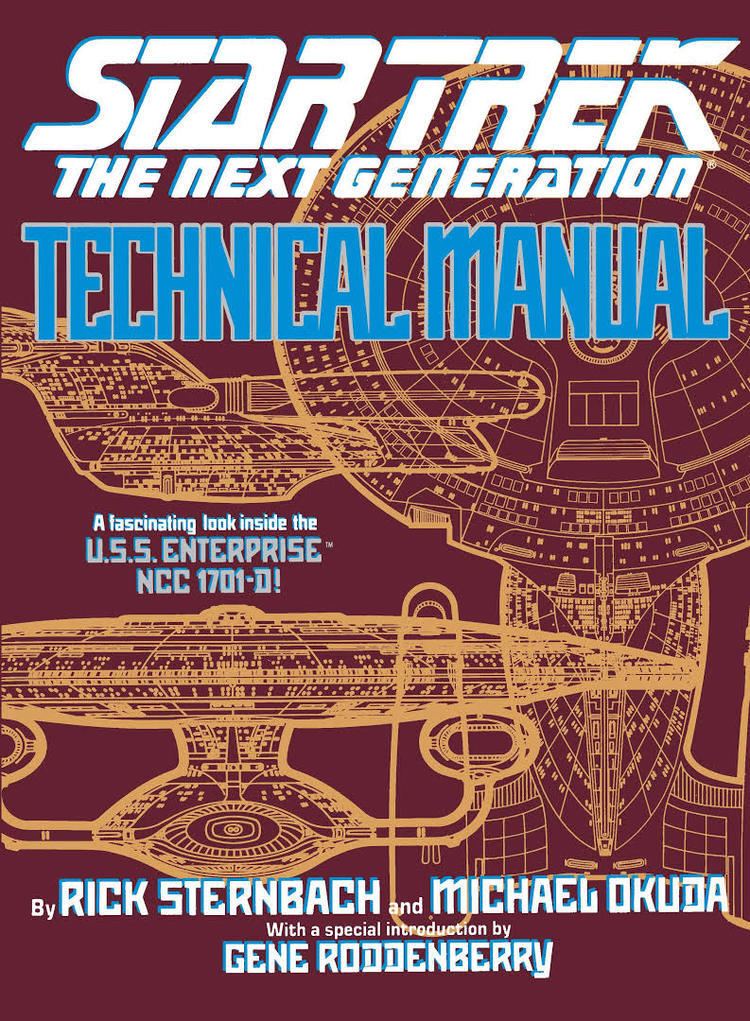8 /10 1 Votes8
4/5 Barnes & Noble Dewey Decimal 791.45/72 20 Originally published 1941 | 4.1/5 Goodreads ISBN 0-671-70427-3 LC Class PN1992.77.S73 S78 1991 OCLC 24648561 | |||||||||||||||||||||||||||||||||
 | ||||||||||||||||||||||||||||||||||
Followed by Star Trek: Deep Space Nine Technical Manual Similar Rick Sternbach books, Television books | ||||||||||||||||||||||||||||||||||
Star Trek: The Next Generation: Technical Manual (ST:TNG TM) is a paperback reference guide detailing the inner and other workings of the fictional Federation starship Enterprise-D and other aspects of technology that appeared in the television series Star Trek: The Next Generation.
Contents
Authored by Rick Sternbach and Michael Okuda, who both worked in the art department on the television series, with a foreword by series creator Gene Roddenberry, the first and only edition was published in 1991 (ISBN 0-671-70427-3) by Pocket Books, and Paramount Pictures holds all copyrights.
Background and contents
The ST:TNG TM is written from the perspective of the 24th century, where TNG is set; it also contains a wealth of behind-the-scenes trivia distinguishable from the technical content. The work is not considered by Paramount to be uncontradictable canon, although many elements first published in the manual have eventually made it onto screen. The book itself claims that elements of it may be false or misleading in order to mislead "threat" forces.
Some ideas developed for the technical manual, or its predecessor, the internal Writers Technical Manual, were later incorporated into the storylines of the TV series and movies. Most notably, a concept drawing from the manual describing an emergency landing of the saucer section was seen by TNG writers Ronald D. Moore, Jeri Taylor, and Brannon Braga who wanted to use a saucer crash as a sixth-season cliffhanger episode for the TV series. This idea was shelved due to budget limitations and resistance from producer Michael Piller. However, Moore and Braga later included the scenario in Star Trek Generations. Also first seen in the technical manual were the Nova-class starship and the USS Galaxy.
The book contains explanations of Warp drive (including a chart showing warp factor against speed, and an explanation that non-fractional warp factors are more efficient than fractional ones), the transporter (which is said to transport matter from place to place keeping it in the form of a "matter stream", and works using analog technology to defeat pattern storage requirements), the replicator (which is said to work on the basis of the transporter, but with a less precise digital resolution), holodecks, phasers and photon torpedoes, impulse drive, the warp core (including a chemical formula for dilithium), subspace radio, saucer separation and landing, the computer, and the various auxiliary craft of the Enterprise. It also contains a section regarding the history of the development of the Galaxy-class ships.
In-jokes
In addition to the more serious material, the manual also contains a number of inside jokes. These include:
Related publications
The print version was later complemented by a similar electronic version, the Star Trek: The Next Generation Interactive Technical Manual.
A follow-up title, the Star Trek: Deep Space Nine Technical Manual, was published in 1998.
